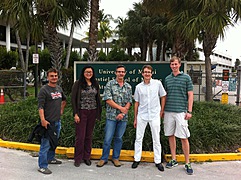Imaging the ocean
by Lars Stemmann, on
Through the PUF project, I visited the Rosenstiel School of Marine and Atmospheric Sciences to talk about imaging systems for the observation of the pelagic ocean.
I gave a seminar titled "Studying pelagic ecosystem dynamics by in situ observation of plankton and particles size distributions using optical cameras". The summary was:
Quantifying chemical elements fluxes through trophic webs and from the surface to the deep ocean requires the ability to detect and identify all organisms and particles in situ and in a synoptic manner. An idealized sensor should observe both the very small particles and protozoa and the extremely large particles such as aggregates, and plankton. Such an instrument would reveal an astonishing amount and diversity of living and non-living particles present in parcel of water and help to understand their dynamics. It is very important to distinguish particles nature (living, non living, organic, minerals) because it has an impact on elements pathways within trophic webs and on vertical fluxes. Unfortunately past sensors did not achieve this goal easily because of their inability to determine particles nature or to be deployed in a synoptic manner. However, recent technological developments now allow better measuring in situ particles and plankton optical properties and size distributions in a way that synoptic surveys are possible. Using recent examples from the literature, my presentation deals with particle and plankton size distributions to show how they help to understand the processes responsible for particulate organic carbon attenuations with depth and the impact of mesoscale hydrodynamics on particle and plankton accumulation or dispersion. I will present the future of imaging technologies to be mounted on autonomous vehicle in a way that coastal or open seas may be monitored using gliders and profiling floats (ARGO floats). Finally, I will suggest how these new data sets could be integrated into size-structured mathematical models of biogeochemical fluxes.
During my stay, I also had two meetings, one with Bob Cowen and his group and one with Claire Paris. The first one was about image recognition, the second was about database and data organization.
We agreed that imaging the pelagic ecosystem needs to be organized in a way that data can be inter-comparable and available easily for collaborations among scientists and also for educational purposes. Probably each system should operate on its own way (including web based application for image analysis and storage) and then there should be a web based application able to cope with the different systems. We will continue to collaborate (in the next weeks) to propose for next ASLO-AGU meeting in Hawaii a workshop on imaging plankton.
Here is a picture of me with Bob Cowen's group. From left to right: Cedric Guigand, Jessica Luo, Bob Cowen, Lars Stemmann, Adam Greer.
